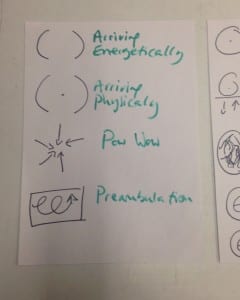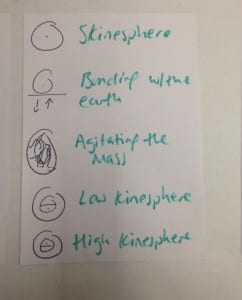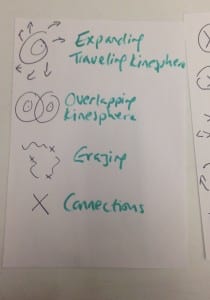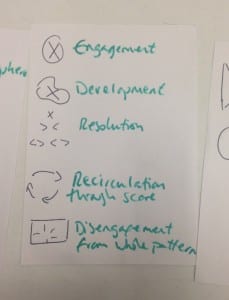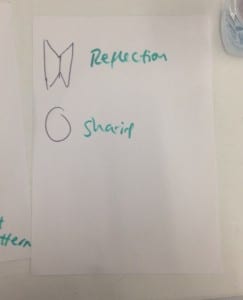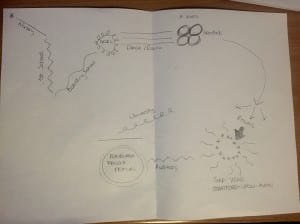Although it is now time to say goodbye to improvisation as a module, it is nowhere near time to say goodbye to it as a practise. Over the course of the past nine weeks I have learnt so much and my eyes have been opened to just how much is available to me. I have grown in confidence, but not just with improvisation, but with my ability to dance in general; I am much more comfortable within myself, knowing that everything is accepted, nothing is right or wrong as long as its personal to you.
A big challenge for everyone was reducing their habitual movement, and looking back now I can’t quite remember what my habitual movements were? And by watching other performers, I find myself wondering what makes them perform those particular movements? I discovered that, unless there is a clear identified strategy, there is nothing making the dancers move in that way, they are completely free in what they want to do. I have never fully appreciated this freedom before and used it to its full potential until now.
Alongside this, involving different strategies has also allowed me to discover how key imagery is when creating new work. It makes you realise how the body can move and articulate in several unusual ways, that may or may not be pleasing to the eye but still not right or wrong. There are infinite amounts of strategies you can behold and to list a few we used such as:
• The left side of your body is crumbling, the right side is stretching.
• Your feet are moving in the opposite direction of your eyes.
• Try to touch your head to your sit bones.
• Your upper kinesphere is spaghetti, your lower kinesphere is knives.
New strategies were introduced each week and provided new challenges. For instance this week, we had to remain in contact with our partner by placing a hand on their pelvis or their hand or both whilst they improvised. Partnered with Zoe, we both liked to challenge each other. Zoe would suddenly dart away from me or drop to the floor, making it difficult to remain in contact. When it was my turn to improvise, I reacted by challenging Zoe back by keeping low to the floor, close to her legs and occasionally sliding between them, making it difficult for her to keep track of me. This was an interesting new exercise to demonstrate how aware we were of each other, whether we were able to predict each other’s movements. It was tempting to use simpler movements in order keep the contact, however this would mean almost falling into habitual movements, and so we were keen to maintain the challenge.
New strategies was something we were keen to include in our group score, in order to maintain our aim of creating an interesting and challenging score. Each performer had to chose 5 or so strategies to use, this provided me with a great opportunity to go back to early challenges I had struggled with in the previous weeks. In week five, I injured my hamstrings and Kayla wanted me to continue with the strategy that I can’t use my legs, this at the time threw me off so much as I arrived at the studio, in normal clothing expecting to sit out after having emailed Kayla, and suddenly being instructed to dance regardless of dance attire or injury. I was determined to come back to this idea of limitations and I did. I limited myself to having legs, yet I am not allowed to use them and ironically, I did not feel limited at all, I was still able to create movement. Perhaps this was because I had given myself time to process the idea but regardless, I felt like this was a small achievement and I even went on to limit myself further to having no arms.
This week we also introduced pop-up scores, using different piles of cards to determine different elements of what we have played with over the past 9 weeks; time, space, form, music, number of performers and audience space. This was the final challenge of the module, combining all that we have learnt, yet it was exciting to finally have everything come together. What was interesting was the introduction of music, looking back at what I said in week one, it used to be easy for anyone to put on a song and dance to it, but now because we see improvisation differently, it actually felt more of a restriction. The music wanted to draw us in to a particular beat, rather than following our own body and pulse and what made this more difficult was if it was a song we already knew being played, (for instance, improvising with Bob Marley playing in the background was unique and quite surreal) as if it was a song we didn’t know, it was easier to ignore it’s beat and follow our own. This made me realise, that as we have practised with the different elements separately, we don’t really see their full influence until they are all put together and affecting each other.
What I have most importantly learnt from this experience, is the amount of responsibility one has in an improvisation. You have a responsibility to be aware of yourself and others in the space, which can sometimes include the audience if they are in close proximity. I know myself that in open group scores I like to contrast with what is happening in the space, such as different dynamics or levels and in the jam this week I discovered I have a responsibility to not cause too much contrast, as I may distract the audience from a performer’s solo which is meant to be the main current focus. Seen as I am now braver to enter the space, I have a responsibility to try not to control the space, as sometimes I like to do almost too much without being aware of everyone else and so I end up crashing into people. I still come out of the space thinking I could of done more, but it is now reassuring knowing that I can re-enter the space with something different when it is appropriate, rather than trying to do everything by remaining in the space. I have also discovered the responsibility of the audience, whether I am an audience member or not. It is important if the audience are also in the space to be aware of them when performing and vice versa, if I am an audience member in the space I have to be aware of the performers around me. This has also helped me realise the power behind the placing of the audience; there are so many places available that in turn affect the overall form of the score, such as performing in the round or having the audience viewing from behind or even viewing upside down.
Similar to what I said in the previous weeks when speaking of how surprisingly quickly time passes when performing a score, it is also surprising how quickly nine weeks of studying improvisation passes. From bean bags to fully fleshed out scores I feel as though I have gone through some sort of transformation in how I feel about dance improvisation. I was just as surprised in each class when I discovered more of what I can do as to when we were told to throw and catch a bean bag in week one and I hope to continue this journey outside of the module to further explore the endless opportunities available to me.
